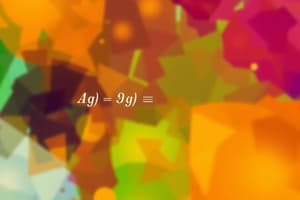Podcast
Questions and Answers
What was a primary focus of the Soviet Union in the initial post-World War II years (1945-1953)?
What was a primary focus of the Soviet Union in the initial post-World War II years (1945-1953)?
- Privatization of state-owned enterprises to encourage foreign investments.
- Reconstruction prioritizing industry and agriculture. (correct)
- Dismantling of the military forces and shifting resources to consumer goods production.
- Rapid expansion of the service sector to improve living standards.
How did the Soviet Union's victory in World War II impact Stalin's authority?
How did the Soviet Union's victory in World War II impact Stalin's authority?
- It led to calls for democratization and decentralization of power.
- It bolstered his prestige which led to a more dictatorial regime. (correct)
- It weakened his position due to the immense human and economic costs.
- It diminished because of criticism from allied nations.
Which of the following best describes the concept of an 'all-encompassing state' (Ολοκληρωτικό κράτος) as it relates to the Soviet Union under Stalin?
Which of the following best describes the concept of an 'all-encompassing state' (Ολοκληρωτικό κράτος) as it relates to the Soviet Union under Stalin?
- A state in which all power is concentrated in the hands of a single person, party or group. (correct)
- A state where economic policies are determined by free market principles.
- A state that promotes individual liberties and freedom of expression.
- A state where power is distributed among different political parties.
What was a key characteristic of the Soviet economic system during the Stalin era?
What was a key characteristic of the Soviet economic system during the Stalin era?
What was a significant change initiated by Khrushchev after Stalin's death?
What was a significant change initiated by Khrushchev after Stalin's death?
What was a defining aspect of Khrushchev's foreign policy?
What was a defining aspect of Khrushchev's foreign policy?
Which of these actions is most representative of Khrushchev's efforts to improve living conditions in the Soviet Union?
Which of these actions is most representative of Khrushchev's efforts to improve living conditions in the Soviet Union?
Which country's leader meeting with Khrushchev symbolized a practical move towards implementing the concept of 'peaceful coexistence'?
Which country's leader meeting with Khrushchev symbolized a practical move towards implementing the concept of 'peaceful coexistence'?
What was a key focus of the Soviet Union's foreign policy during the Brezhnev era?
What was a key focus of the Soviet Union's foreign policy during the Brezhnev era?
How did the economic development of the Soviet Union change during the Brezhnev era compared to Khrushchev's time?
How did the economic development of the Soviet Union change during the Brezhnev era compared to Khrushchev's time?
Flashcards
Totalitarian State
Totalitarian State
A state where one person, party, or group holds all power.
Peaceful coexistence
Peaceful coexistence
Theory advocating economic and political cooperation between countries with different systems.
De-Stalinization
De-Stalinization
Nikita Khrushchev condemned Stalin's cult of personality.
Reconstruction
Reconstruction
Signup and view all the flashcards
Nikita Khrushchev
Nikita Khrushchev
Signup and view all the flashcards
Stalin
Stalin
Signup and view all the flashcards
Study Notes
Vector Functions of a Real Variable
- A vector function of a real variable maps a real number to a vector in $R^n$.
- Defined as $\mathbf{r}: I \subseteq \mathbb{R} \rightarrow \mathbb{R}^{n}$, where for each real number $t$ in the interval $I$, $\mathbf{r}(t)$ is a vector in $\mathbb{R}^{n}$.
- $\mathbf{r}(t)$ can be expressed as $\mathbf{r}(t)=\left(f_{1}(t), f_{2}(t), \ldots, f_{n}(t)\right)$, where $f_{i}: I \subseteq \mathbb{R} \rightarrow \mathbb{R}$ are real-valued functions.
Trajectory of a Vector Function
- The trajectory of a vector function is the set of all points $\mathbf{r}(t)$ in $\mathbb{R}^{n}$, for all $t$ in the domain of $\mathbf{r}$.
- It represents the curve traced by the tip of the vector $\mathbf{r}(t)$ as $t$ varies.
Example Vector Function 1
- Function: $\mathbf{r}(t)=2 \cos (t) \mathbf{i}+2 \operatorname{sen}(t) \mathbf{j}, \quad 0 \leq t \leq 2 \pi$
- Parametric equations: $x=2 \cos (t)$ and $y=2 \operatorname{sen}(t)$
- The functions satisfy the equation $x^{2}+y^{2}=4$.
- The curve traced is a a circle of radius 2 centered at the origin
Example Vector Function 2
- Function: $\mathbf{r}(t)=\cos (t) \mathbf{i}+\operatorname{sen}(t) \mathbf{j}+t \mathbf{k}$
- The $\mathbf{i}$ and $\mathbf{j}$ components define a circle in the xy-plane.
- The $\mathbf{k}$ component ($z=t$) causes the curve to rise or descend as ( t ) increases.
- The function results in a helical curve winding around the z-axis.
Direct Stress
- Also known as simple stress.
- Includes tension, compression, and shear stress.
Tension Stress
- Stress caused by pulling forces.
- Calculated as $\sigma = \dfrac{F}{A}$, where $\sigma$ is stress, $F$ is applied force, and $A$ is cross-sectional area.
- Elongation is considered positive.
Compression Stress
- Stress caused by pushing forces.
- Calculated as $\sigma = \dfrac{F}{A}$, where $\sigma$ is stress, $F$ is applied force, and $A$ is cross-sectional area.
- Deformation is considered negative.
Shear Stress
- Stress caused by forces acting parallel to a member.
- Calculated as $\tau = \dfrac{V}{A}$, where $\tau$ is shear stress, $V$ is shear force, and $A$ is the area.
Bearing Stress
- Contact pressure between two bodies.
- Calculated as $\sigma_b = \dfrac{F}{A_b}$, where $\sigma_b$ is bearing stress, $F$ is applied force, and $A_b$ is bearing area.
- For a cylinder, ( A_b = t \cdot d ), with ( t ) being plate thickness and ( d ) being cylinder diameter.
Example Problem
- A steel bar with a cross-sectional area of 4 $in^2$ is under a tensile force of 70,000 lbs.
- Tensile stress is ( \sigma = \dfrac{F}{A} = \dfrac{70,000 \ lbs}{4 \ in^2} = 17,500 \ psi ).
Studying That Suits You
Use AI to generate personalized quizzes and flashcards to suit your learning preferences.



